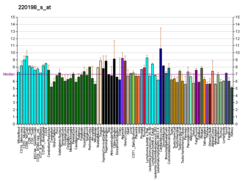EIF5A2
Protein-coding gene in the species Homo sapiens
| EIF5A2 | |||||||||||||||||||||||||||||||||||||||||||||||||||
|---|---|---|---|---|---|---|---|---|---|---|---|---|---|---|---|---|---|---|---|---|---|---|---|---|---|---|---|---|---|---|---|---|---|---|---|---|---|---|---|---|---|---|---|---|---|---|---|---|---|---|---|
| Identifiers | |||||||||||||||||||||||||||||||||||||||||||||||||||
| Aliases | EIF5A2, EIF-5A2, eIF5AII, eukaryotic translation initiation factor 5A2 | ||||||||||||||||||||||||||||||||||||||||||||||||||
| External IDs | OMIM: 605782; MGI: 1933735; HomoloGene: 1490; GeneCards: EIF5A2; OMA:EIF5A2 - orthologs | ||||||||||||||||||||||||||||||||||||||||||||||||||
| |||||||||||||||||||||||||||||||||||||||||||||||||||
| |||||||||||||||||||||||||||||||||||||||||||||||||||
| |||||||||||||||||||||||||||||||||||||||||||||||||||
| |||||||||||||||||||||||||||||||||||||||||||||||||||
| |||||||||||||||||||||||||||||||||||||||||||||||||||
| Wikidata | |||||||||||||||||||||||||||||||||||||||||||||||||||
| |||||||||||||||||||||||||||||||||||||||||||||||||||
Eukaryotic translation initiation factor 5A-2 is a protein that in humans is encoded by the EIF5A2 gene.[5]
References
- ^ a b c GRCh38: Ensembl release 89: ENSG00000163577 – Ensembl, May 2017
- ^ a b c GRCm38: Ensembl release 89: ENSMUSG00000050192 – Ensembl, May 2017
- ^ "Human PubMed Reference:". National Center for Biotechnology Information, U.S. National Library of Medicine.
- ^ "Mouse PubMed Reference:". National Center for Biotechnology Information, U.S. National Library of Medicine.
- ^ "Entrez Gene: EIF5A2 eukaryotic translation initiation factor 5A2".
Further reading
- Jenkins ZA, Hååg PG, Johansson HE (2001). "Human eIF5A2 on chromosome 3q25-q27 is a phylogenetically conserved vertebrate variant of eukaryotic translation initiation factor 5A with tissue-specific expression". Genomics. 71 (1): 101–9. doi:10.1006/geno.2000.6418. PMID 11161802.
- Guan XY, Sham JS, Tang TC, et al. (2001). "Isolation of a novel candidate oncogene within a frequently amplified region at 3q26 in ovarian cancer". Cancer Research. 61 (9): 3806–9. PMID 11325856.
- Strausberg RL, Feingold EA, Grouse LH, et al. (2003). "Generation and initial analysis of more than 15,000 full-length human and mouse cDNA sequences". Proceedings of the National Academy of Sciences of the United States of America. 99 (26): 16899–903. Bibcode:2002PNAS...9916899M. doi:10.1073/pnas.242603899. PMC 139241. PMID 12477932.
- Clement PM, Henderson CA, Jenkins ZA, Smit-McBride Z, Wolff EC, Hershey JW, Park MH, Johansson HE (2003). "Identification and characterization of eukaryotic initiation factor 5A-2". European Journal of Biochemistry. 270 (21): 4254–63. doi:10.1046/j.1432-1033.2003.03806.x. PMID 14622290.
- Guan XY, Fung JM, Ma NF, et al. (2004). "Oncogenic role of eIF-5A2 in the development of ovarian cancer". Cancer Res. 64 (12): 4197–200. doi:10.1158/0008-5472.CAN-03-3747. PMID 15205331. S2CID 6823741.
- Gerhard DS, Wagner L, Feingold EA, et al. (2004). "The status, quality, and expansion of the NIH full-length cDNA project: the Mammalian Gene Collection (MGC)". Genome Research. 14 (10B): 2121–7. doi:10.1101/gr.2596504. PMC 528928. PMID 15489334.
- Christensen GL, Ivanov IP, Atkins JF, et al. (2005). "Screening the SPO11 and EIF5A2 genes in a population of infertile men". Fertility and Sterility. 84 (3): 758–60. doi:10.1016/j.fertnstert.2005.03.053. PMID 16169419.
- Clement PM, Johansson HE, Wolff EC, Park MH (2006). "Differential expression of eIF5A-1 and eIF5A-2 in human cancer cells". The FEBS Journal. 273 (6): 1102–14. doi:10.1111/j.1742-4658.2006.05135.x. PMC 4406228. PMID 16519677.
- Xie D, Ma NF, Pan ZZ, Wu HX, Liu YD, Wu GQ, Kung HF, Guan XY (2008). "Overexpression of EIF-5A2 is associated with metastasis of human colorectal carcinoma". Human Pathology. 39 (1): 80–6. doi:10.1016/j.humpath.2007.05.011. PMID 17949776.
- Yang GF, Xie D, Liu JH, Luo JH, Li LJ, Hua WF, Wu HM, Kung HF, Zeng YX, Guan XY (2009). "Expression and amplification of eIF-5A2 in human epithelial ovarian tumors and overexpression of EIF-5A2 is a new independent predictor of outcome in patients with ovarian carcinoma". Gynecol. Oncol. 112 (2): 314–8. doi:10.1016/j.ygyno.2008.10.024. PMID 19054548.
- Chen W, Luo JH, Hua WF, Zhou FJ, Lin MC, Kung HF, Zeng YX, Guan XY, Xie D (2009). "Overexpression of EIF-5A2 is an independent predictor of outcome in patients of urothelial carcinoma of the bladder treated with radical cystectomy". Cancer Epidemiology, Biomarkers & Prevention. 18 (2): 400–8. doi:10.1158/1055-9965.EPI-08-0754. PMID 19155439. S2CID 9907553.
- Luo JH, Hua WF, Rao HL, Liao YJ, Kung HF, Zeng YX, Guan XY, Chen W, Xie D (2009). "Overexpression of EIF-5A2 predicts tumor recurrence and progression in pTa/pT1 urothelial carcinoma of the bladder". Cancer Science. 100 (5): 896–902. doi:10.1111/j.1349-7006.2009.01126.x. PMC 11158472. PMID 19298601. S2CID 23225065.
- Tang DJ, Dong SS, Ma NF, Xie D, Chen L, Fu L, Lau SH, Li Y, Li Y, Guan XY (2010). "Overexpression of eukaryotic initiation factor 5A2 enhances cell motility and promotes tumor metastasis in hepatocellular carcinoma". Hepatology. 51 (4): 1255–63. doi:10.1002/hep.23451. PMID 20112425. S2CID 5328378.
- Chen M, Huang JD, Deng HK, Dong S, Deng W, Tsang SL, Huen MS, Chen L, Zan T, Zhu GX, Guan XY (2011). "Overexpression of eIF-5A2 in mice causes accelerated organismal aging by increasing chromosome instability". BMC Cancer. 11: 199. doi:10.1186/1471-2407-11-199. PMC 3118894. PMID 21612665.
- He LR, Zhao HY, Li BK, Liu YH, Liu MZ, Guan XY, Bian XW, Zeng YX, Xie D (2011). "Overexpression of eIF5A-2 is an adverse prognostic marker of survival in stage I non-small cell lung cancer patients". International Journal of Cancer. 129 (1): 143–50. doi:10.1002/ijc.25669. PMID 20830705. S2CID 205942112.
- v
- t
- e
| Initiation factor |
| ||||||||||||||||||||
|---|---|---|---|---|---|---|---|---|---|---|---|---|---|---|---|---|---|---|---|---|---|
| Elongation factor |
| ||||||||||||||||||||
| Release factor | |||||||||||||||||||||
| Ribosomal Proteins |
|
 | This article on a gene on human chromosome 3 is a stub. You can help Wikipedia by expanding it. |
- v
- t
- e

















